Abstract
Two injection tests, shallow and deep, followed by repeated temperature logging were performed in the Lake City, California OH-1 corehole, to delineate permeable zones, investigate the permeability of rocks adjacent to the wellbore, and to test the validity of maximum-reading thermometer (MRT) measurements collected during the drilling process that show lower than static temperatures above a depth of 2100 ft and significantly higher than static temperatures below a depth of about 2500 ft. The tests confirmed several permeable zones in OH-1. At about 300 ft, there is a strong zone of lateral flow, and at 947 ft there is a major outflow zone for injected fluid. Two other possible permeable flow zones were detected from the thermal recovery logs: one at about 1500 ft and another at about 2300 ft. The 2300 ft permeable zone seems to be an inflow zone, and the source of a probable downflow responsible for cooling the wellbore below about 2500 ft. The hotter MRT data obtained during drilling may be reconciled with the significantly lower static temperature logs if downflow from about 2300 ft is present.
Similar content being viewed by others
References
Espinosa-Paredes, G., and Garcia-Guiterrez, A., 2002, Estimation of static formation temperatures in geothermal well: Energy and Conversión Management, v. 44, p. 1343–1355.
Hardyman, R. F., 2002, Lake City Geothermal, LLC Lake City Observation Hole No. 1, unpubl. lithologic description of core from OH-1, 59 p.
Lachenbruch, A. H., and Brewer, C. M., 1959, Dissipation of the temperature effect of drilling a well in Arctic Alaska: U.S. Geol. Survey Bull., B 1083C, p. 73–109.
McKenna, J. R., 2003, Wil.exe: A program to perform wellbore equilibrium temperature extrapolations and delineate flow zones in boreholes: unpubl. reprt.
Richards, M. R., and Blackwell, D. D., 2002, A difficult search, why Basin and Range systems are hard to find: Geothermal Bull., 31, no. 2, p. 143–146.
Wisian, K. W., Blackwell, D. D., Bellani, S., Henfling, J. A., Normann, R. A., Lysne, P. C., Förster, A., and Schrötter, J., 1998, Field comparison of conventional and new technology temperature logging systems: Geothermics, v. 27, no. 2, p. 131–142.
Author information
Authors and Affiliations
Corresponding author
Rights and permissions
About this article
Cite this article
McKenna, J.R., Benoit, W.R., Goranson, C.B. et al. Injection experiments and thermal recovery in corehole OH-1, Lake City, California. Nat Resour Res 13, 241–253 (2004). https://doi.org/10.1007/s11053-004-0132-7
Received:
Accepted:
Issue Date:
DOI: https://doi.org/10.1007/s11053-004-0132-7




